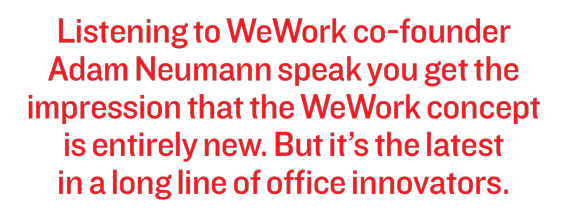A century ago, Frederick Taylor, an American mechanical engineer, had an idea: design factories and offices in a way that would maximize workplace productivity. He described his vision, which became known as Taylorism, as human progress. “In the past man has been first,” he wrote. “In the future the system must be first.”
On the face of it, the co-working giant WeWork, with its Ping Pong tables, beer kegs and bike racks, seems to have little in common with the austere bullpens that Taylor popularized in the early 20th century. But the two share an important goal. They both set out to transform office life. “We are changing the way people work,” WeWork’s co-founder Adam Neumann told The Real Deal back in 2013, before his company achieved celebrity status and a $10 billion valuation.
And while Neumann has chosen different buzzwords to describe his mission, he is no doubt standing on Taylor’s shoulders.
Taylor, writing at a time of rapid industrialization and mechanization, believed that the future belonged to his “system.” Similarly, Neumann, speaking in the age of Uber and Airbnb, believes he is ushering in the work “community.”
“What we really were attracted to was community,” Neumann said at a recent TechCrunch conference. “And if you understand that you are part of the sharing economy and by leveraging community you can become more successful, then you are part of the ‘We Generation.’”
Listening to Neumann speak, you get the impression that WeWork is something never seen before. And in many senses — like the way it’s given startups incubator spaces to launch from — it is. But in a broader sense, it’s also the latest in a long line of office innovators.
All about the work
 Nikil Saval’s 2014 book “Cubed: A Secret History of the Workplace,” begins in the 19th century, when counting houses — simple rooms or spaces where businesses operated from — were the offices of the day. But they gave way to huge corporate offices as companies grew amid industrialization and globalized trade.
Nikil Saval’s 2014 book “Cubed: A Secret History of the Workplace,” begins in the 19th century, when counting houses — simple rooms or spaces where businesses operated from — were the offices of the day. But they gave way to huge corporate offices as companies grew amid industrialization and globalized trade.
Downtown office districts and skyscrapers, Saval argued, sprung up as status-conscious white-collar managers looked to separate themselves from the working class factory workers.
When companies grew more concerned about speeding up productivity at work in the early 20th century, Taylorism — which touted open floor plans rather than the small, separated rooms in use at the time — gained momentum.
Meanwhile, the entry of women into the workforce led to all sorts of anxieties among the male managerial class. In Manhattan’s old MetLife Building, hallways, elevators and other areas were strictly separated by sex. “In the Taylorist fashion, work was distributed in such a way as to keep people busy during their entire work day, and electric clocks kept rigorous time, while supervisors ensured that no quiet conversation, let alone loud talking or laughing, took place,” Saval wrote of the MetLife headquarters.
Unsurprisingly, these offices weren’t exactly fun to work in. By the middle of the 20th century, companies began to recognize that happy workers might be more productive.
The result was glass office towers like the Seagram Building and the Lever House, along with suburban campuses that had more daylight and amenities. The television series Mad Men recently revived the world of the mid-century office as a place of comfort and aspiration.
At Connecticut General’s campus outside Hartford, bowling alleys, tennis courts, a game room and a large cafeteria were included to ensure that employees would never have to leave.
In the cities, meanwhile, offices began to look more luxurious. “Devotion to business had become a sort of religion,” Saval wrote of the time. (Decades later, tech companies like Google would take that concept to the next level with offices resembling adult playgrounds.)
 But for most workers, the office of 1950s remained much the dreary place it had been in the early 20th century.
But for most workers, the office of 1950s remained much the dreary place it had been in the early 20th century.
Soon, however, the office sector found its next prophet.
In 1964, a designer named Robert Propst unveiled a concept that he believed would revolutionize how people worked. Billed as the “Action Office,” the design was all about giving people flexibility and ramping up creativity. There were multiple desks, some on wheels, as well as semi-enclosed walls to provide a measure of privacy.
Despite positive press, the “Action Office” never took off. But amid rising real estate costs, the concept of using flexible furniture and temporary partitions to cram a lot of people into open office floor plans did.
Much to his dismay, Propst became known as the father of the cubicle. The cubicle, which was designed to free up the workers in “action offices,” had the opposite effect, becoming a symbol of dull conformity. But it did offer companies a cheap and flexible layout.
Today, many consider a WeWork office — with its glass enclosure and access to ping pong tables and beer kegs — to be the anti-cubicle. Whether WeWork’s office design catches on more widely or morphs into something new is an unknown. But sources say their timing was spot-on.
“Forty percent of the economy works as freelancers at this point,” said Richard Greenwald, a labor historian and dean at Brooklyn College.
“There’s a sense that in order to find your next gig you have to be around people that are in the know,” he said. “They’ve plugged into that need.”
He added: “I don’t see this whole thing ending.”
